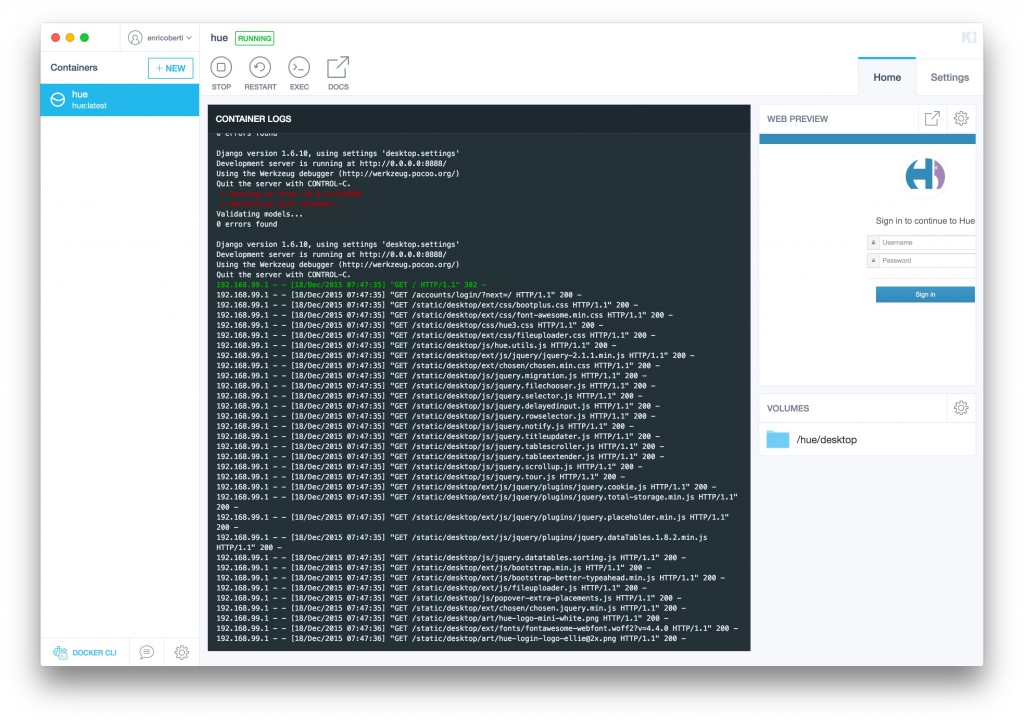2015-12-18-getting-started-with-hue-in-2-minutes-with-docker.md 5.6 KB
title: Getting started with Hue in 1 minute with Docker author: admin type: post date: 2015-12-18T15:35:33+00:00 url: /getting-started-with-hue-in-2-minutes-with-docker/ sf_thumbnail_type:
- none sf_thumbnail_link_type:
- link_to_post sf_detail_type:
- none sf_page_title:
- 1 sf_page_title_style:
- standard sf_no_breadcrumbs:
- 1 sf_page_title_bg:
- none sf_page_title_text_style:
- light sf_background_image_size:
- cover sf_social_sharing:
- 1 sf_sidebar_config:
- left-sidebar sf_left_sidebar:
- Sidebar-2 sf_right_sidebar:
- Sidebar-1 sf_caption_position:
- caption-right sf_remove_promo_bar:
- 1 ampforwp-amp-on-off:
- default categories:
- Administration
Update March 2019: this post was refresh in Hue in Docker
The current way to play with Hue is often to go on demo.gethue.com or download a Virtual Machine. However, these have some limitations. Using Docker instead provides a much better experience as it:
- is lighter and more robust than a VM
- gives admin permissions
- has much faster execution
Docker makes it perfect for quick starting on Hue development or pointing Hue to your current cluster and giving it a try. This is for this that we now provide a Docker image of Hue!

Please find below a video showing how to start Hue with Docker on a Mac and instructions for Linux users.
[]7{#user-content-get-the-docker-image.anchor}Get the docker image
They are two ways: just pull the latest from the Internet or build it yourself from the Hue repository.
[]9{#user-content-pull-the-image-from-docker-hub.anchor}Pull the image from Docker Hub
{{< highlight bash >}}sudo docker pull gethue/hue:latest
{{< /highlight >}}
[]10{#user-content-build-the-image.anchor}Build the image
{{< highlight bash >}}cd tools/docker/hue-base
sudo docker build -rm -t gethue/hue:latest .
{{< /highlight >}}
[]11{#user-content-running-the-image.anchor}Running the image
{{< highlight bash >}}docker run -it -p 8888:8888 gethue/hue:latest bash
{{< /highlight >}}
This opens a bash to the root of the project. From there you can run the development version of Hue with the command
{{< highlight bash >}}./build/env/bin/hue runserver_plus 0.0.0.0:8888
{{< /highlight >}}
Hue should then be up and running on your default Docker IP on the port 8888, so usually http://192.168.99.100:8888.
Note If 192.168.99.100 does not work, get the IP of the docker container with:
{{< highlight bash >}}sudo docker ps
CONTAINER ID IMAGE COMMAND CREATED STATUS PORTS NAMES
b7950388c1 gethue/hue:latest "bash" 10 minutes ago Up 10 minutes 22/tcp, 0.0.0.0:8888->8888/tcp agitated_mccarthy
{{< /highlight >}}
Then get inet addr, so in our case http://172.17.0.1:8888:
{{< highlight bash >}}sudo docker exec -it b7950388c1 /sbin/ifconfig eth0
eth0 Link encap:Ethernet HWaddr 02:42:ac:11:00:01
inet addr:172.17.0.1 Bcast:0.0.0.0 Mask:255.255.0.0
inet6 addr: fe80::42:acff:fe11:1/64 Scope:Link
UP BROADCAST RUNNING MULTICAST MTU:1500 Metric:1
RX packets:67 errors:0 dropped:0 overruns:0 frame:0
TX packets:8 errors:0 dropped:0 overruns:0 carrier:0
collisions:0 txqueuelen:0
RX bytes:10626 (10.6 KB) TX bytes:648 (648.0 B)
{{< /highlight >}}
[]14{#user-content-next.anchor}Next
You can then configure Hue and start using it!
Read more about how to configure Hue. The development version uses the configuration file desktop/conf/pseudo-distributed.ini.
